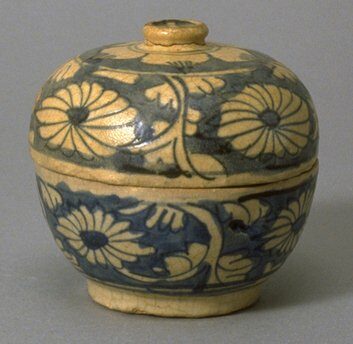Blue-and-white covered box with chrysanthemum design
Kiln Unknown, Vietnam

Description
March 28, 2009
These covered boxes with blue underglaze painting are examples of the prime wares exported from Vietnam to the Southeast Asian island countries. Although blue-and-white stonewares were first produced exclusively in China, increasing demand from the international market made the Vietnamese kilns highly competitive in the production of less expensive types. Not unlike the international car industry in the modern era, it was common for these kilns to copy their rivals’ popular models and sell them at cheaper prices. Blue-and-white shards of Chinese Ming wares have been found at kiln sites in Vietnam and in Thailand, another major competitor. The covered box with chrysanthemum design shown here is almost an exact copy of a Ming porcelain.
(Label for UMMA South and Southest Asia Gallery Opening Rotation, March 2009)
Subject Matter:
A small ceramic box decorated with chrysanthemum scrolls. Both the chrysanthemum motif and the technique of underglaze blue painting were adopted from Chinese prototypes, but the shape of this box, the tones of the cobalt blue, and the casual free-hand drawing are distintively Vietnamese.
Covered boxes were used as burial objects to accompany the dead. This practice for the care of deceased people in afterlife preceded the succession of foreign religious influence from Buddhism, Hinduism to Islam. The stoneware trade ceramics were also objects of status and wealth, for the local kilns only produced less durable and inexpensive earthernwares. The round shape with a handle, and some of the design motifs were adopted from stone and metal reliquaries and architectural elements came with Indian Hinduism and Buddhism.
Physical Description:
A round ceramic box (that is, a bowl with a fitted lid), decorated with chrysanthemum scrolls drawn in blue outline against a blue background. The blue is cobalt pigment painted before the application of a clear glaze.
Usage Rights:
If you are interested in using an image for a publication, please visit https://umma.umich.edu/request-image/ for more information and to fill out the online Image Rights and Reproductions Request Form.